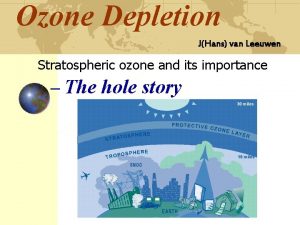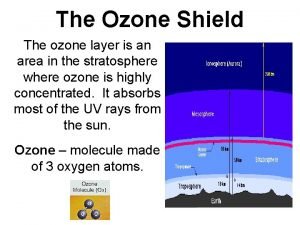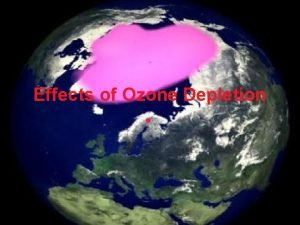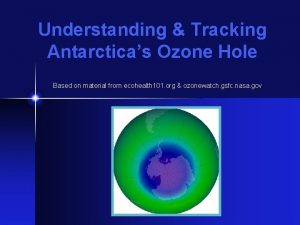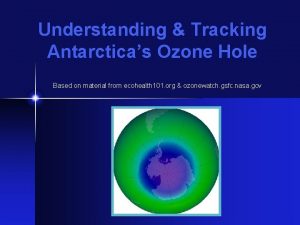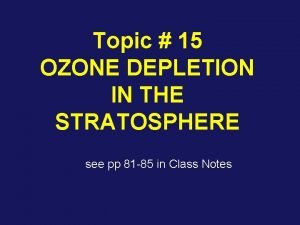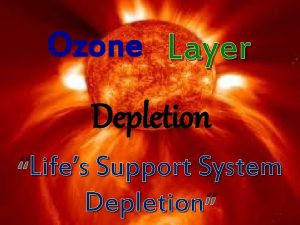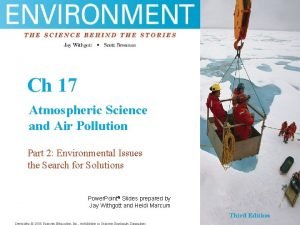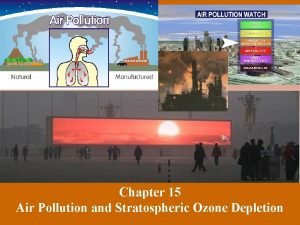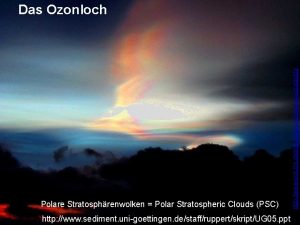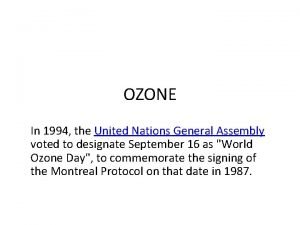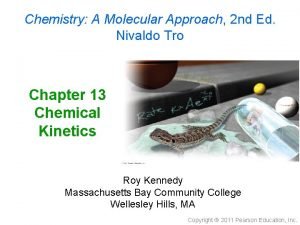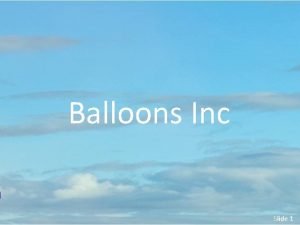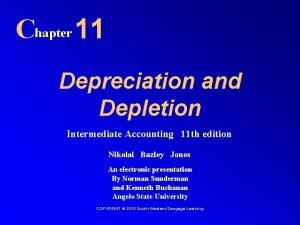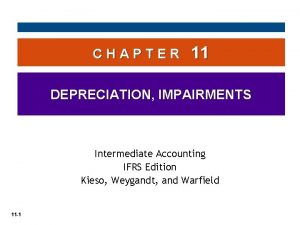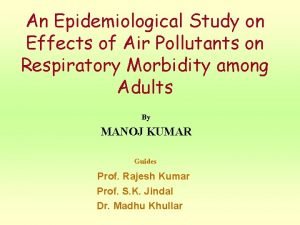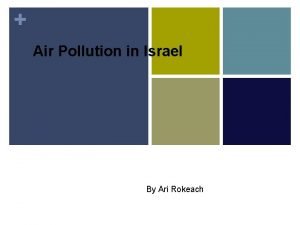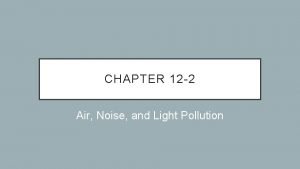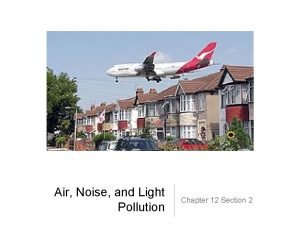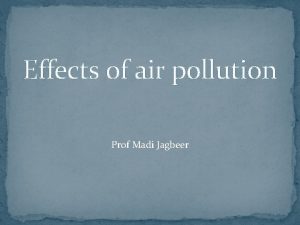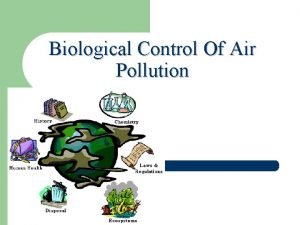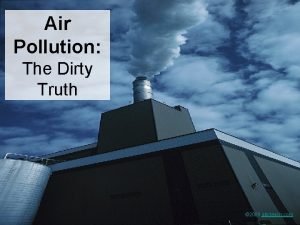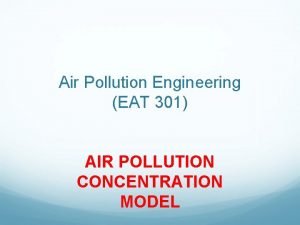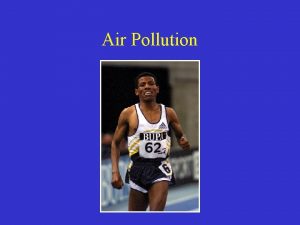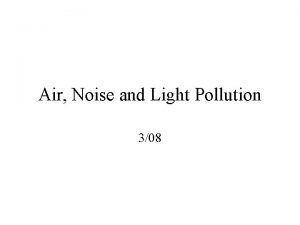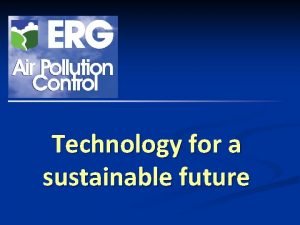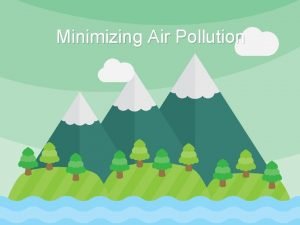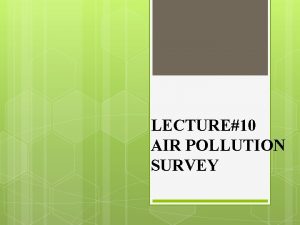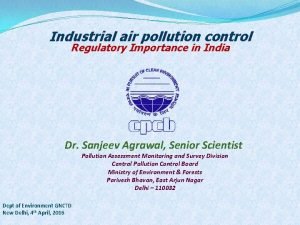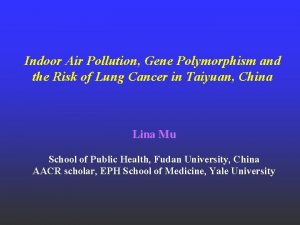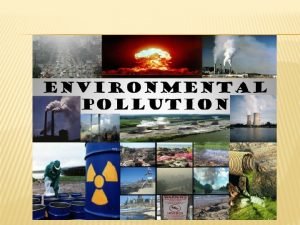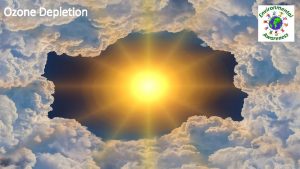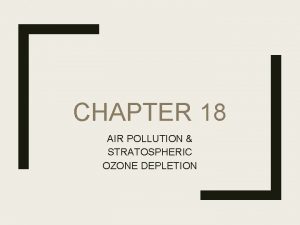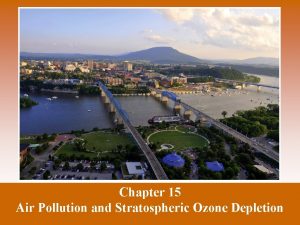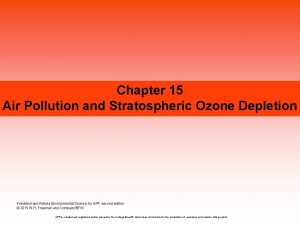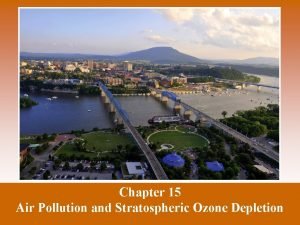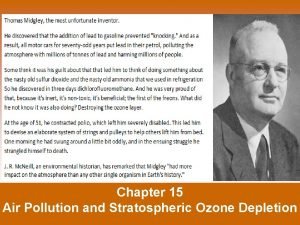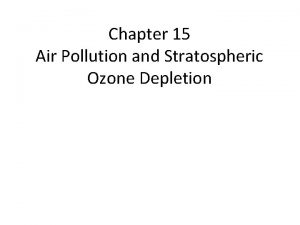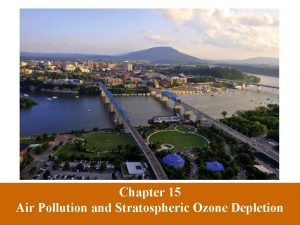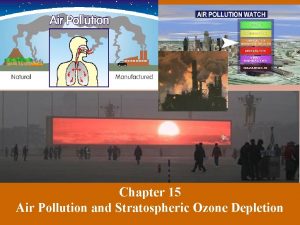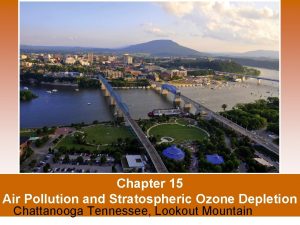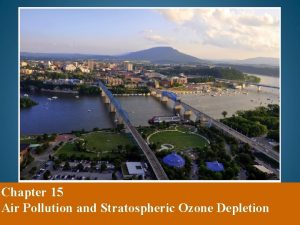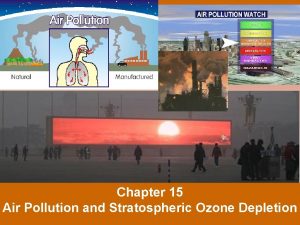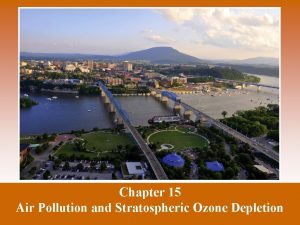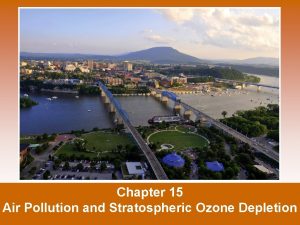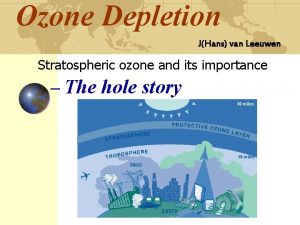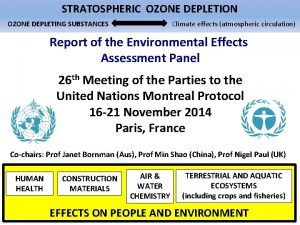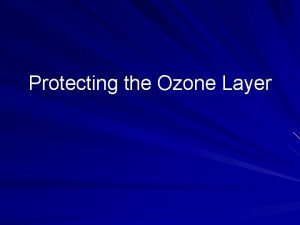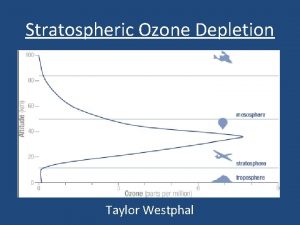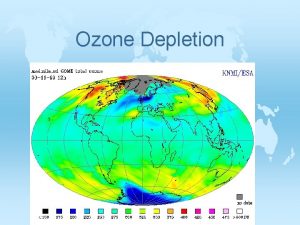Chapter 15 Air Pollution and Stratospheric Ozone Depletion









































- Slides: 41

Chapter 15 Air Pollution and Stratospheric Ozone Depletion

Cleaning Up Chattanooga • Chattanooga, TN – natural basin formed by Appalachian Mts • Environmental cost of economic boom surrounding mountains trap pollutants • 1969 – US survey determined Chattanooga’s air quality is BAD • Response – Chattanooga created Air Pollution Control Ordinance • 1972 • To continue to maintain clean air, programs were started: • Comprehensive recycling program • Electric buses • Problems still experiencing – continued increase of ozone concentration

Air Pollution • Air pollution- the introduction of chemicals, particulate matter, or microorganisms into the atmosphere at concentrations high enough to harm plants, animals, and materials such as buildings, or to alter ecosystems • Some stats: • Air pollution is a global system • Inputs • Outputs

Major Air Pollutants • • Sulfur Dioxide Nitrogen Oxides Carbon Oxides Particulate Matter Volatiles Organic Compounds Ozone Lead Mercury

Sulfur Dioxide • Sulfur released combines with oxygen sulfur dioxide • SO 2 released from volcanic eruptions too

Nitrogen Oxides • NOx x can either be one or two oxygen atoms • NO – colorless, odorless gas • NO 2 – pungent, reddish-brown gas

Carbon oxides • Carbon monoxide/dioxide – colorless, odorless gas

Particulate Matter • Particulates, aka: particles • Solid or liquid particles suspended in air • Ranges in size • PM 10 vs PM 2. 5 • Haze – reduced visibility

Particulate Matter

Photochemical Oxidants, including Tropospheric Ozone • Photochemical oxidants – class of air pollutants formed as a result of sunlight acting on compounds, such as NOx and SO 2 • Ozone (a photochemical oxidant) – O 3 • Smog – mixture of oxidants and particulate matter • 2 categories: • Photochemical smog • Sulfurous smog

Lead and Other Metals • Lead • US phased out leaded gasoline between 1975 – 1996 • Mercury • Problem because mercury bioaccumulates

Volatile Organic Compounds • Abbreviated as VOCs • Organic compounds that become vapors at typical atmospheric temperatures • Many are hydrocarbons • Important in the formation of ozone

Primary Pollutants • Primary pollutantspolluting compounds that come directly out of the smokestack, exhaust pip, or natural emission source. • Examples: CO, CO 2, SO 2, NOx, and most suspended particulate matter. • Also many VOCs

Secondary Pollutants • Secondary pollutants - pollutants that have undergone transformation in the presence of sunlight, water, oxygen, or other compounds. • Examples: • Ozone • Sulfate • Nitrate

Natural Sources of Air Pollution • • Volcanoes Lightning Forest fires Plants

Anthropogenic Sources of Air Pollution • Many are monitored, regulated and controlled by EPA, in categories: • Transportation • Power plants • Industrial processes • Waste disposal

Anthropogenic Emissions, Air Quality • Clean Air Act and amendments – require EPA establish standards to control pollutants that are harmful to “human health and welfare” • National Ambient Air Quality Standards (NAAQS) –EPA periodically specifies concentration limits for each air pollutant • In US : • Air quality in other countries not so promising:

Ozone Nonattainment Areas • From Environment, 6 th Edition • US Urban Areas with Worst Air Quality, 2002

Photochemical Smog • Formation of photochemical smog: • Not limited to urban areas • Effect of temperature:

Photochemical Smog, Another View… From Environment, 6 th Edition

Thermal Inversions • Thermal Inversion- when a relatively warm layer of air at mid-altitude covers a layer of cold, dense air below • Traps emissions that then accumulate beneath it • Common in cities • Can exacerbate other forms of pollution

Acid Deposition • Acid deposition- occurs when nitrogen oxides and sulfur oxides are released into the atmosphere and combine with atmospheric oxygen and water • In US:

Effects of Acid Deposition • Lowering the p. H of lake water • Decreasing species diversity of aquatic organisms • Mobilizing metals found in soils and releasing into surface waters • Food web • Human health more affected by precursors • Damaging statues, monuments, and buildings

Ways to Prevent Air Pollution • Removing sulfur dioxide from coal by fluidized bed combustion • Catalytic converters on cars • Scrubbers on smoke stacks • Baghouse filters • Electrostatic precipitators

Control of Sulfur and Nitrogen Oxide Emissions • Fluidized bed combustion – removes SO 2 from coal exhaust during combustion • What about NOx? • Lower burn temperatures and amount of oxygen • Catalytic converter in vehicles

Control of Particulate Matter • Most common means of pollution control • Sulfur • Simplest method gravitational settling • Ash residue– must be disposed of in landfill • And the others… • Downsides: • Use energy and increase resistance to air flow in factory/power plant • Require use of fuels = more CO 2 emissions

Control of PM Baghouse Filter • Fabric filters – allow gases to pass through but not particulate matter • Can remove almost 100% of PM

Control of PM Electrostatic Precipitator Without Electrostatic precipitator With Electrostatic precipitator

Control of PM Scrubbers

Smog Reduction • Difficult to overcome smog problem • Must try to reduce primary pollutant that contribute to smog production • Reducing VOCs in urban areas • Reducing NOx emissions

“Innovative” Pollution Control From Environment, 6 th Edition • Vapor Recovery System for gasoline • Decrease sulfur oxides • Lower combustion temperature • Mass transit • No-tillage • Advanced furnaces/engines • Careful handling of petroleum and hydrocarbons • **Your textbook has specific examples…

Stratospheric Ozone • The stratospheric ozone layer exists roughly 45 -60 kilometers above the Earth • Ozone (O 3) – absorbs ultraviolet radiation and protect life on Earth • UV-radiation: • UV-A • UV-B • UV-C

Formation and Breakdown of Ozone • Formation: • First, UV-C radiation breaks the bonds holding together the oxygen molecule, leaving two free oxygen atoms: O 2 + UV-C 2 O • Sometimes the free oxygen atoms result in ozone: O 2 + O O 3 • Breakdown: • Ozone is broken down into O 2 and free oxygen atoms when it absorbs both UV-C and UV-B ultraviolet light: O 3 + UV-B or UV-C O 2 + O

Anthropogenic Contributions to Ozone Destruction • Certain chemicals can break down ozone, particularly chlorine • Major source of chlorine in the stratosphere is chlorofluorocarbons (CFCs) • CFCs are used: • Very stable, inert, (not able to move), nontoxic and nonflammable

Anthropogenic Contributions to Ozone Destruction • CFCs are released into the troposphere move to the stratosphere. • Ultraviolet radiation breaks the bond connecting chlorine to CFC • Chlorine can then break apart the ozone molecules: • Step 1: O 3 + Cl Cl. O + O 2 • Step 2: Cl. O + O Cl + O 2 • One chlorine atom can catalyze the breakdown of as many as 100, 000 ozone molecules before it leaves the stratosphere • Other molecules that can break down stratospheric ozone

Depletion of the Ozone Layer • Global Ozone concentrations decreased >10% • Depletion was greatest at the poles, but occurred worldwide • Decreased stratospheric ozone = increased the amount of UV-B radiation on surface of Earth • Effects?

Efforts to Reduce Ozone Depletion • Montreal Protocol on Substances that Deplete the Ozone Layer (1987) • 24 nations signed • After a few amendments, signed by 180 countries • Committed to concrete steps towards solution and resolving to reduce CFC production by 50% by year 2000 • Outcome:

Indoor Air Pollutants • Pollutants can be 5 -100 X greater than outdoors • Difference between HDCs and LDCs: • Developing – people use wood, animal manure or coal used for cooking and heating • Developed – many factors contribute

Some Sources of Indoor Air Pollution

Indoor Air Pollutants • Asbestos – thin, fibrous silicate mineral with insulating properties • Health risks - • Carbon Monoxide – result from malfunctioning exhaust systems on heaters • Health risks - • Radon – gas that occurs naturally from decay of uranium • Health risks - • VOCs in home products – used in building materials, furniture and other home products (glue and paint) • Health risks -

Sick Building Syndrome • Due to increased effort to improve insulation and prevention of air leaks (to reduce heating/cooling costs) buildup of toxic compounds and pollutants • Causes – • 4 specific reasons for SBS:
 Stratospheric ozone depletion
Stratospheric ozone depletion Ozone depletion negative effects
Ozone depletion negative effects Ozone depletion effect on humans
Ozone depletion effect on humans Causes of the ozone depletion
Causes of the ozone depletion Ozone layer depletion introduction
Ozone layer depletion introduction Ozone depletion diagram
Ozone depletion diagram Cause of ozone depletion
Cause of ozone depletion Ozone layer depletion
Ozone layer depletion Ozone layer depletion
Ozone layer depletion Ozone depletion pictures
Ozone depletion pictures Chapter 12 section 1 what causes air pollution
Chapter 12 section 1 what causes air pollution Chapter 12 air section 1 what causes air pollution
Chapter 12 air section 1 what causes air pollution Polar stratospheric clouds
Polar stratospheric clouds Polar stratospheric clouds
Polar stratospheric clouds Polar stratospheric clouds
Polar stratospheric clouds Stratospheric balloon
Stratospheric balloon Chapter 11 depreciation impairments and depletion
Chapter 11 depreciation impairments and depletion Which method is used to compute depletion?
Which method is used to compute depletion? Kunci jawaban buku intermediate accounting ifrs chapter 11
Kunci jawaban buku intermediate accounting ifrs chapter 11 Air higroskopis adalah
Air higroskopis adalah 2 causes of soil pollution
2 causes of soil pollution Soil pollution images diagram
Soil pollution images diagram Air pollution aim
Air pollution aim Secondary pollutant examples
Secondary pollutant examples Stationary and mobile sources of air pollution
Stationary and mobile sources of air pollution Baghouse filter definition apes
Baghouse filter definition apes Section 2 air noise and light pollution
Section 2 air noise and light pollution Section 2 air noise and light pollution
Section 2 air noise and light pollution Measures of noise pollution
Measures of noise pollution Introduction of pollution
Introduction of pollution Effect of air pollution to plants
Effect of air pollution to plants Contents of air pollution
Contents of air pollution Main cause of air pollution
Main cause of air pollution Air pollution box model example
Air pollution box model example General effects of air pollution
General effects of air pollution Air pollution consequences
Air pollution consequences Erg air pollution control
Erg air pollution control Air pollution
Air pollution Objectives of air pollution
Objectives of air pollution Air pollution
Air pollution Air pollution
Air pollution Air pollution class 9
Air pollution class 9
